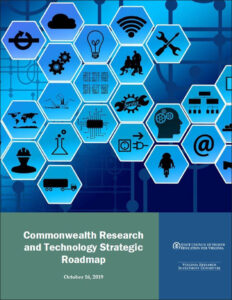A new study, “The Commonwealth Research and Technology Strategic Roadmap,” has identified six strategic technology clusters exhibiting the greatest potential for Virginia’s economic growth. The report, conducted by the State Council of Higher Education for Virginia, is not prescriptive — it does not offer legislative recommendations. Rather, the report identifies fruitful areas for collaboration between education, industry, government, and economic developers.
The most promising areas for focused research and economic development include:
- Life and health science
- Autonomous systems
- Space and utilities
- Agricultural and environmental technologies
- Cybersecurity
- Data science analytics
Collaboration should take the form of aligning investments in R&D, talent development, industry engagement, capacity building (such as venture capital), and marketing/advocacy for the purpose of globally competitive industry clusters.
Life and health sciences. Life and health sciences is a broad field. The Roadmap identifies several “sub-verticals” in which Virginia has the potential to build critical mass:
- Neuroscience (advanced technologies and regulated products)
- Biomedical informatics
- Medical and surgical devices
- Advanced biopharmaceutical manufacturing
- Synthetic biology — the application of engineering principles to the redesign and fabrication of new biological components and systems.
Among the assets cited by the report: the Virginia Catalyst’s Neuroscience Initiative; a $120 million donation to the University of Virginia to create a School of Data Science; the $1.4 billion of Virginia-based spine surgical device company K2M by Stryker, a leading medical technology company; and a 37% increase in new biopharmaceutical companies in Virginia between 2014-16.
Autonomous systems. The Roadmap identified these sub-verticals:
- Teaming — coordination and interoperability between land, air and seafaring autonomous vehicles.
- Remote sensing — antennas, radars, lidars, integrated optics.
- Command and control — hardware and decentralized capabilities in the defense sector.
- Urban air mobility — arising from research at NASA Langley.
- Communications protocols (5G and others) — integration with next-generation cellular networks for remote access and control of various autonomous systems.
Among the assets cited: the physical proximity of the Port of Virginia, the NASA Wallops Flight Facility, and various branches of the armed forces; supporting industries such as Volvo and Huntington Ingalls Newport News Shipbuilding; the recent acquisition of Virginia Tech spin-off Torc Robotics by Daimler; and research at the Commonwealth Center for Advanced Manufacturing on autonomous robots, advanced sensing and “smart factories.”
Space and satellites. The Roadmap points to the following sub-verticals:
- Small satellites — next-generation satellites will be smaller, and there will be more of them.
- Commercial spacecraft
- Commercial rockets
- Communications protocols — satellite communications with next-generation cellular networks
“While space and satellites is a mature industry in Virginia, significant market shifts warrant continued and enhanced investment around research, development and commercialization in this area,” the report says. “Spaceflight and rocket launch barriers to market entry have decreased, and startups are infiltrating the market.”
Key assets: Virginia’s Mid-Atlantic Spaceport (MARS) is one of four FAA-approved spaceports; Rocket Labs was selected for venture funding; and Rocket Labs selected the NASA Wallops Flight Facility to locate its second small satellite orbital launch complex.
Agricultural and environmental technologies. The Roadmap prioritized the following sub-verticals:
- Precision agriculture — crop efficiency
- Water purification/filtration
- Biodesigned food sources — bio stimulants and microbiome enhancements. Efforts to yield more nutritious and resilient plant and livestock food sources.
- Sea level rise — increased sea levels and associated flooding risks from environmental degradation.
The document pointed to Virginia’s oyster industry as an area that meets the triple bottom line of social, economic and environmental impact. Oysters are more than a source of food. The natural filter feeders help purify rivers and waterways, while oyster reefs buffer shorelines from erosion.
As special assets in the Commonwealth, the Roadmap cites the large size of Virginia’s agricultural sector; the presence of Hampton Roads as the world’s largest and deepest natural harbor; Virginia Tech’s Smart Farm network, which spreads the use of precision agriculture, autonomous systems, and biodesign; Mahindra Corporation’s selection of Blacksburg as the location for its new research center to design farm technology products; and a $120 million federal grant for resilience projects in Hampton Roads, including $5 million to create a resilience innovation hub.
Cybersecurity. Cybersecurity is a mature area of focus in Virginia, notes the report, but it will continue to be of importance. Virginia has numerous leading-edge strengths in this area.
- The highest concentration of cyber-security jobs of all 50 states; 3.3 times the national concentration level.
- The Commonwealth Cyber Initiative, a $25 million cyber-ecosystem talent-development, research-and-commercialization, and industry collaboration.
- Amazon’s decision to locate its HQ2 project in Virginia.
Data science and analytics.
The Roadmap identified the following key assets:
- Virginia (and especially Northern Virginia) supports the world’s leading cluster of data centers. In 2018, NoVa’s data center footprint absorbed 270 megawatts of the global market; London, the second largest, absorbed 69 megawatts.
- Northern Virginia has the highest density of dark fiber (unused fiber optic cable) in the world.
- Virginia ranks 2nd highest in the concentration of tech sector employment nationally.


Leave a Reply
You must be logged in to post a comment.